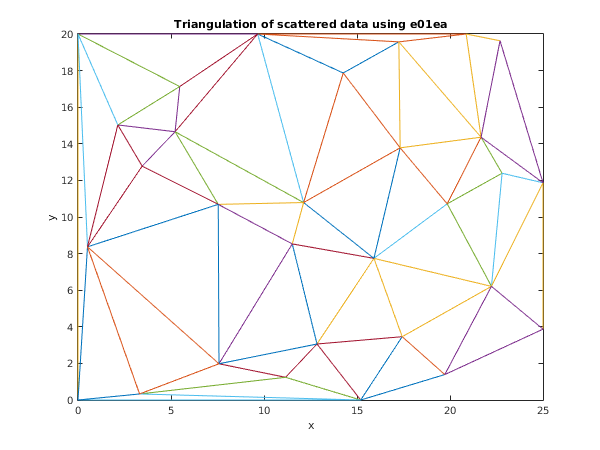PDF version (NAG web site
, 64-bit version, 64-bit version)
NAG Toolbox: nag_interp_2d_triangulate (e01ea)
Purpose
nag_interp_2d_triangulate (e01ea) generates a triangulation for a given set of two-dimensional points using the method of Renka and Cline.
Syntax
Description
nag_interp_2d_triangulate (e01ea) creates a Thiessen triangulation with a given set of two-dimensional data points as nodes. This triangulation will be as equiangular as possible (
Cline and Renka (1984)). See
Renka and Cline (1984) for more detailed information on the algorithm, a development of that by
Lawson (1977). The code is derived from
Renka (1984).
The computed triangulation is returned in a form suitable for passing to
nag_interp_2d_triang_bary_eval (e01eb) which, for a set of nodal function values, computes interpolated values at a set of points.
References
Cline A K and Renka R L (1984) A storage-efficient method for construction of a Thiessen triangulation Rocky Mountain J. Math. 14 119–139
Lawson C L (1977) Software for surface interpolation Mathematical Software III (ed J R Rice) 161–194 Academic Press
Renka R L (1984) Algorithm 624: triangulation and interpolation of arbitrarily distributed points in the plane ACM Trans. Math. Software 10 440–442
Renka R L and Cline A K (1984) A triangle-based interpolation method Rocky Mountain J. Math. 14 223–237
Parameters
Compulsory Input Parameters
- 1:
– double array
-
The coordinates of the data points.
- 2:
– double array
-
The coordinates of the data points.
Optional Input Parameters
- 1:
– int64int32nag_int scalar
-
Default:
the dimension of the arrays
x,
y. (An error is raised if these dimensions are not equal.)
, the number of data points.
Constraint:
.
Output Parameters
- 1:
– int64int32nag_int array
-
A data structure defining the computed triangulation, in a form suitable for passing to
nag_interp_2d_triang_bary_eval (e01eb). Details of how the triangulation is encoded in
triang are given in
Further Comments. These details are most likely to be of use when plotting the computed triangulation which is demonstrated in
Example.
- 2:
– int64int32nag_int scalar
unless the function detects an error (see
Error Indicators and Warnings).
Error Indicators and Warnings
Errors or warnings detected by the function:
-
-
Constraint: .
-
-
On entry, all the pairs are collinear.
-
An unexpected error has been triggered by this routine. Please
contact
NAG.
-
Your licence key may have expired or may not have been installed correctly.
-
Dynamic memory allocation failed.
Accuracy
Not applicable.
Further Comments
The time taken for a call of
nag_interp_2d_triangulate (e01ea) is approximately proportional to the number of data points,
. The function is more efficient if, before entry, the
pairs are arranged in
x and
y such that the
values are in ascending order.
The triangulation is encoded in
triang as follows:
- set ; for each node, , (using the ordering inferred from x and y)
-
-
- , for , contains the list of nodes to which node is connected. If then node is on the boundary of the mesh.
Example
In this example,
nag_interp_2d_triangulate (e01ea) creates a triangulation from a set of data points.
nag_interp_2d_triang_bary_eval (e01eb) then evaluates the interpolant at a sample of points using this triangulation. Note that this example is not typical of a realistic problem: the number of data points would normally be larger, so that interpolants can be more accurately evaluated at the fine triangulated grid.
Open in the MATLAB editor:
e01ea_example
function e01ea_example
fprintf('e01ea example results\n\n');
x = [11.16; 12.85; 19.85; 19.72; 15.91; 0.00;
20.87; 3.45; 14.26; 17.43; 22.80; 7.58;
25.00; 0.00; 9.66; 5.22; 17.25; 25.00;
12.13; 22.23; 11.52; 15.2; 7.54; 17.32;
2.14; 0.51; 22.69; 5.47; 21.67; 3.31];
y = [ 1.24; 3.06; 10.72; 1.39; 7.74; 20.00;
20.00; 12.78; 17.87; 3.46; 12.39; 1.98;
11.87; 0.00; 20.00; 14.66; 19.57; 3.87;
10.79; 6.21; 8.53; 0.00; 10.69; 13.78;
15.03; 8.37; 19.63; 17.13; 14.36; 0.33];
[triang] = e01ea(x, y);
n = size(x,1);
t = int64([0;0;0]);
max_t = int64(2*n-5);
tri = int64(zeros(max_t,3));
iend = int64(0);
k = int64(0);
for i = 1:n
ibeg = iend + 1;
iend = triang(6*n+i);
t(1) = i;
t(2) = triang(ibeg);
ibeg = ibeg + 1;
for j = ibeg:iend
t(3) = triang(j);
if t(3)>0
if t(2)>i || t(3)>i
k = k + 1;
tri(k,1:3) = t(1:3);
end
t(2) = t(3);
end
end
end
fprintf('Number of triangles in triangulation = %d\n',k);
%display mesh
fig1 = figure;
trimesh(tri(1:k,1:3),x,y)
xlabel('x');
ylabel('y');
title('Triangulation of scattered data using e01ea');
f = [22.15; 22.11; 7.97; 16.83; 15.30; 34.60; 5.74; 41.24; 10.74; ...
18.60; 5.47; 29.87; 4.40; 58.20; 4.73; 40.36; 6.43; 8.74; ...
13.71; 10.25; 15.74; 21.60; 19.31; 12.11; 53.10; 49.43; 3.25; ...
28.63; 5.52; 44.08];
px = [2.0500 3.7500 5.0000 8.5400 9.1400];
py = [1.7750 3.2500 5.0000 2.0500 4.4500];
[pf, ifail] = e01eb(...
x, y, f, triang, px, py);
fprintf('\n px py Interpolated Value\n');
disp([px' py' pf]);
e01ea example results
Number of triangles in triangulation = 88
px py Interpolated Value
2.0500 1.7750 48.2100
3.7500 3.2500 41.4195
5.0000 5.0000 36.1613
8.5400 2.0500 28.2458
9.1400 4.4500 24.4543
PDF version (NAG web site
, 64-bit version, 64-bit version)
© The Numerical Algorithms Group Ltd, Oxford, UK. 2009–2015
